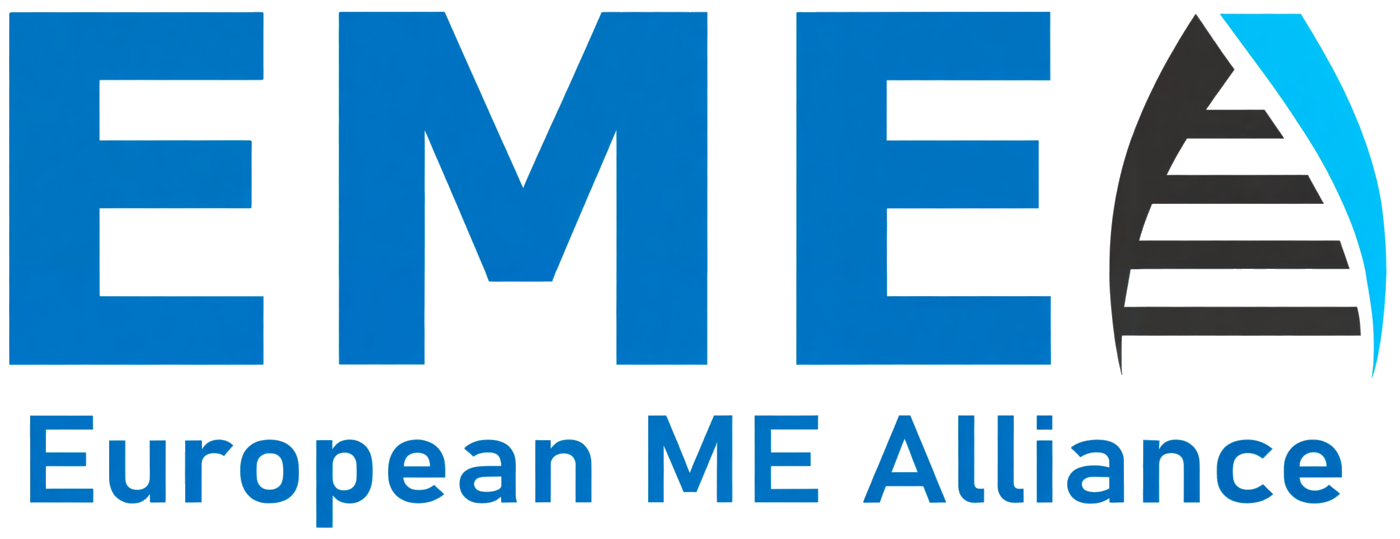 European ME Alliance
European ME Alliance
The members of the European ME Alliance have put forward a petition to the European Parliament in Brussels. EMEA feel there is an urgent requirement to address the perception, treatment and research into myalgic encephalomyelitis.
Letters have been sent to all of the Alliance's members of the European Parliament -
|
Dear Members of the European Parliament,
The European ME Alliance (EMEA) is a grouping of European organisations that are involved in supporting patients suffering from myalgic encephalomyelitis (ME) - (in some countries ME is embraced in the term ME/CFS or even CFS) and the Alliance campaigns for a strategy of biomedical research into ME in order to provide treatments and cures for this neurological disease.
The Alliance consists of member organisations from Belgium, Germany, Holland, Ireland, Italy, Norway, Spain, Sweden, Switzerland, Denmark and UK.
The representatives of the European ME Alliance wish to ask for your support of the attached petition. The petition seeks to ensure that member states of the EU abide by, enforce and respect the following: -
EMEA Belgium will represent the Alliance in any discussions with the EU that are held in Brussels.
We hope we can count on your support for this petition.
Yours Sincerely,
The Chairman, Board and Members of the European ME Alliance
European ME Alliance
|
![]()
|
PETITION
References
1.
G93.3 Postviral fatigue syndrome Benign myalgic encephalomyelitis (ME) 2. Carruthers B, Jain AK, De Meirleir KL, Peterson DL, Klimas NG, Lerner AM, Bested AC, Flor-Henry P, Joshi P, Powles AP, et al.: Myalgic encephalomyelitis/chronic fatigue syndrome: clinical working case definition, diagnostic and treatment protocols. Journal of chronic fatigue syndrome 2003, 11(1):7-115.
3. Carruthers BM, van de Sande MI, De Meirleir KL, Klimas NG, Broderick G, Mitchell T et al. Myalgic encephalomyelitis: International Consensus Criteria. J Intern Med 2011;270:327–38.
4. Nacul LC, Lacerda EM, Campion P, Pheby D, Drachler MD, Leite JC, Poland F, Howe A, Fayyaz S, Molokhia M: The functional status and well being of people with myalgic encephalomyelitis/chronic fatigue syndrome and their carers. BMC Public Health 2011, 11(1):402.
5. J. Mark Van Ness, Staci R. Stevens, Kylie T. Kumasaka, Harnoor Singh, Betsy Keller, Daniel L. Peterson, Jose Montoya and Christopher R. Snell: A diagnostic test for the identification of metabolic dysfunction. Conference abstract 9th IACFS/ME clinical and research conference, Reno, March 7, 2009.
6. Brown, M. M., Bell, D. S., Jason, L. A., Christos, C. and Bell, D. E. (2012), Understanding Long-Term Outcomes of Chronic Fatigue Syndrome. J. Clin. Psychol., 68: 1028–1035. doi: 10.1002/jclp.21880
7. Twisk, F.N., Maes, M., 2009. A review on cognitive behavioral therapy (CBT) and graded exercise therapy (GET) in myalgic encephalomyelitis (ME)/ chronic fatigue syndrome (CFS): CBT/GET is not only ineffective and not evidence-based, but also potentially harmful for many patients with ME/CFS. Neuro Endocrinology Letters 30 (3), 284–299.
8. KCE report: Evaluation of CBT/GET therapy. https://kce.fgov.be/nl?SGREF=5268&CREF=11648
9. Fluge Ø, Bruland O, Risa K, Storstein A, Kristoffersen EK, et al. (2011) Benefit from B-Lymphocyte Depletion Using the Anti-CD20 Antibody Rituximab in Chronic Fatigue Syndrome. A Double-Blind and Placebo-Controlled Study. PLoS ONE 6(10): e26358. doi:10.1371/journal.pone.0026358
10. Maes M, Twisk FN: Chronic fatigue syndrome: Harvey and Wessely's (bio)psychosocial model versus a bio(psychosocial) model based on inflammatory and oxidative and nitrosative stress pathways. BMC Med 8:35. 11. Broderick G, Fuite J, Kreitz A, Vernon SD, Klimas N, Fletcher MA. A formal analysis of cytokine networks in chronic fatigue syndrome. Brain Behav Immun. 2010 Oct;24(7):1209-17.
12. Komaroff AL, Cho TA: Role of infection and neurologic dysfunction in chronic fatigue syndrome. Seminars in Neurology 2011, in press.
For further information 1. Klimas NG, Salvato FR, Morgan R, Fletcher MA. Immunologic abnormalities in chronic fatigue syndrome. J Clin Microbiol 1990; 28: 1403-10. [PMID: 2166084] 2. Myhill S, Booth NE, McLaren-Howard J. Chronic fatigue syndrome and mitochondrial dysfunction. Int J Clin Exp Med 2009; 2: 1-16. [PMID: 19436827] 3. Peckerman, A., LaManca, J.J., Dahl, K.A., Chemitiganti, R., Qureishi, B., Natelson, B.H., 2003. Abnormal impedance cardiography predicts symptom severity in chronic fatigue syndrome. American Journal of Medical Sciences 326 (2), 55–60. 4. Streeten DH, Thomas D, Bell DS. The roles of orthostatic hypotension, orthostatic tachycardia and subnormal erythrocyte volume in the pathogenesis of the chronic fatigue syndrome. Am J Med 2000; 320: 1-8. [PMID: 10910366] 5. Kerr JR, Burke B, Petty R, et al. Seven genomic subtypes of chronic fatigue syndrome/myalgic encephalomyelitis; a detailed analysis of gene network and clinical phenotypes. J Clin Pathol 2008; 61: 730-739. [PMID: 18057078] 6. Tirelli U, Chierichetti F, Tavio M, Simonelli C, Bianchin G, Zanco P, Ferlin G. Brain positron emission tomography (PET) in chronic fatigue syndrome: preliminary data. Amer J Med 1998; 105: 54S-8S. [PMID: 9790483] 7. Goldstein JA. Chronic Fatigue Syndrome: The Limbic Hypothesis. Binghamptom, New York: Haworth Medical Press; 1993:19, 116. 8. Chia J, Chia A, Voeller M, Lee T, Chang R. Acute enterovirus infection followed by myalgic encephalomyelitis/chronic fatigue syndrome and viral persistence. J Clin Pathol 2010; 63: 163-8. [PMID: 19828908] 9. Pall ML. Explaining “Unexplained Illnesses”: Disease Paradigm for Chronic Fatigue Syndrome, Multiple Chemical Sensitivity, Fibromyalgia, Post-Traumatic Stress Disorder, Gulf War Syndrome and Others. Bighamton, NY: Harrington Park (Haworth) Press, 2007. 10. Meeus M, Nijs J, McGregor N, Meeusen R, De Schutter G, Truijen S, Frémont M, Van Hoof E, De Meirleir K.: Unravelling intracellular immune dysfunctions in chronic fatigue syndrome: interactions between protein kinase R activity, RNase L cleavage and elastase activity, and their clinical relevance. In Vivo. 2008 Jan-Feb;22(1):115-21.PMID:18396793 [PubMed - indexed for MEDLINE]
For an objective view of the establishment intrigue surrounding ME we recommend:
Magical Medicine: How to Make a Disease Disappear by Professor Malcolm Hooper [click here]
Professor Hooper has made a formal complaint to the Minister of State responsible for the Medical Research Council.
|
![]()
|
See the petition document in other languages | ||||
| Belgium |
Denmark |
Holland |
France |
Ireland |
|
Italy |
Germany |
Norway |
Sweden |
UK |
|
Last Update: 22 October 2012 |

